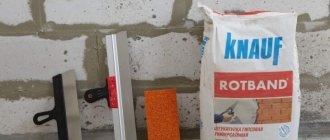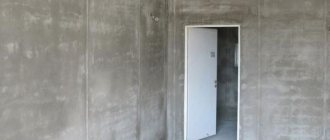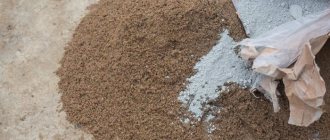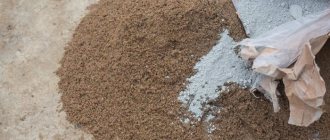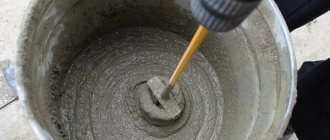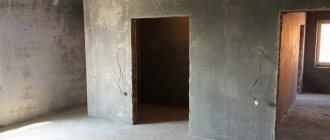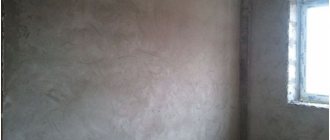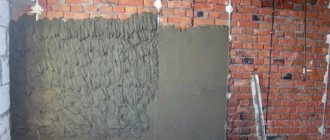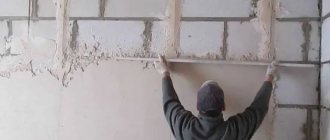Products in category
Quick-hardening self-leveling floor Osnovit SKORLINE T-45, 20 kg
319.99 rub.
| Quick-hardening self-leveling floor Osnovit SKORLINE T-45, 20 kg 319.99 rub. | Quick-hardening self-leveling floor Osnovit SKORLINE T-45, 20 kg 319.99 rub. | Quick-hardening self-leveling floor Osnovit SKORLINE T-45, 20 kg 319.99 rub. | Quick-hardening self-leveling floor Osnovit SKORLINE T-45, 20 kg 319.99 rub. |
Briefly about sand concrete
The composition of sand concrete consists of the following components:
- sand (responsible for the parameters of strength and plasticity of the dry residue);
- Portland cement (affects the rate of hardening, resistance to loads);
- additional components: granite powder and plasticizers. Improves characteristics - strength and density. If necessary, you can adjust the parameters of moisture resistance, frost resistance and hardening speed.
Carrying out calculations
Construction mixtures are packaged in sealed bags, weight varies from 25 to 50 kg. Therefore, when drawing up cost estimates, you should decide how many bags of sand concrete are needed per 1 cubic meter of finished mortar. If we talk about the volume of one unit of popular mixtures per cubic meter. m, then it looks like this:
- 25 kg: 0.01-0.019;
- 40 kg: 0.017-0.03;
- 50 kg: 0.021-0.038.
The specified data will help you find the consumption of CPS per 1 m3 of finished solution
Using ready-made formulas, we calculate the number of packages using the following algorithm:
- find the total number of cubic meters of the finished solution;
- we calculate the content of sand concrete in the resulting volume;
- cubes of sand concrete must be converted into kg, and accordingly into bags.
The working solution is prepared by mixing a variety of components. Let's consider the consumption of the working solution of the mixture and water for popular brands. So, for M100 you will need 550-570 kg per cubic meter, M150 - 570-590, M200 - 590-620, M300: 620-660, M400: 660-710.
In addition to the density of the CPS, it is important to take into account the mass fraction of cement and the sand fraction. After all, the higher they are, the greater the weight of 1 cubic meter of solution. Regarding consumption, the parameters of the planned monolith must be taken into account.
Making cement-sand mortar with your own hands
To reduce the cost of work, especially for large areas, you usually prepare the solution yourself, selecting the strength and taking into account the base material.
Cement is hard and non-plastic; it is difficult to apply and level. It sets within an hour, so you need to plan on using more plaster than normal. The most common is a composition where three parts of sand are added to one part of cement.
Proportions
The addition of lime improves ductility; the optimal composition is considered to be a proportion of 1:0.5:5.5, resulting in a solution of strength M75. Usually a cement-lime composition is used, it is suitable for external and internal work. Setting occurs in 1–2 hours; thanks to lime, it adheres better to the base.
Why do you need a concrete screed?
In any room, a screed is installed on the floor. Most often, screeds are made from cement-sand mortars or concrete mixtures. This layer of mortar serves as the base for the finishing coat, or as a rough layer for the finishing screed. In technical rooms, garages, baths, a well-made screed can serve as a floor.
Since the screed is the basis for laying the floor covering, the quality of its execution affects the strength and durability of the floor.
The screed performs the following functions:
- levels the surface for the future floor covering, which is crucial when installing the floor;
- increases structural strength;
- if necessary, creates the desired floor slope and changes its level;
- distributes the load evenly over the floor surface;
- closes utility lines;
- increases sound and heat insulation of the floor.
What regulatory documents should be used when calculating
Standards for plastering walls were drawn up a long time ago and over the years have been repeatedly tested in practice by many builders. To determine the material consumption per 1 m2, only 2 regulatory documents are required, namely:
- SNiP 3.04.01-87. The standards have been drawn up specifically to determine the thickness and quality of both insulating and finishing coatings.
- Standard indicators of material consumption (NPRM) Collection 15.02 Plastering works. The collection is quite extensive and is recommended by the State Construction Committee of Russia as information material for the development of construction estimates. Standards and types of finishing materials for any surface are given.
Many of the data specified in SNiP 3.04.01-87 or in the more current version SP 71.13330.2017 are also in NPRM, but in an abbreviated version. No more regulatory documents are required to calculate consumption.
Mixture consumption per 1 m2 of surface
In the collection 15.02 NPRM you will find all the tables with consumption rates for various types of plaster (lime, cement, cement-lime mortar). For ease of understanding, its GOST is indicated next to the solution, and the consumption of mesh, plaster and dowels is also given. An inconvenience arises when calculating the amount of mixture per 1 m2, when the data is given in relation to 1 m3/100 m2 of area.
Consumption per 1 m2 with the condition that the material is applied in one layer (layer thickness - 1 cm):
- Plaster – 9 kg.
- Cement or cement-lime mortar – 17 kg.
- "Rotband". The main difference between the mixture and standard gypsum mortar is the presence of adhesion-improving additives. The consumption of the Rotband mixture per 1 m2 is 8.5 kg.
- "Bark beetle." "Bark beetle" is often used for finishing the facades of buildings and much less often - indoors. This type of plaster has several varieties, but on average its consumption is 3 kg per 1 m2.
- "Volma". Volma plaster is popular due to the variety of products - there are at least 22 types. One of the most common is “Volma-layer”, and its consumption ranges from 8 kg.
- Venetian plaster. It is more suitable as a filling option, since its layer should be very thin, so the consumption of the “Venetian” is as economical as possible: 200 g per 1 m2.
Consumption per square meter for some types of plasters - Vetonit. It is widely used due to its relatively low consumption. The composition of Vetonit mainly includes: cement (base), sand, limestone and microfiber. Consumption: 1.5 kg per 1 m2.
- "Teplon". Gypsum-based plaster is valued for its high environmental friendliness, affordability in terms of pricing policy and high-quality vapor permeability. Teplon consumption is 1.8 kg.
Important! If the surface is too deformed or there are cracks and potholes, you should add a certain amount of material to the already calculated one. Sometimes it is simply enough to round the estimate number up if it is not a whole number.
Layer thickness calculation
The layer should be sufficient to achieve a smooth surface and hide imperfections based on the minimum thickness. An excess layer, in addition to increasing the cost of work, will lead to a decrease in the durability of the coating. The thickness depends on the condition of the surface, its curvature and material.
comparison table
Depending on the base, the applied layer may be different:
- A brick wall is characterized by good adhesion and the presence of relief; the layer cannot be thinner than half a centimeter. The recommended layer without reinforcement is 2.5 centimeters, with mesh – up to 5 centimeters.
- Concrete has porosity, good adhesion, the applied layer is recommended from 2 millimeters. You should not apply more than 2 centimeters without a mesh; the greatest thickness with reinforcement is up to 5–7 centimeters.
- Aerated concrete and foam block walls are smooth, 2–15 millimeters thick is enough.
- Wood is rarely plastered due to poor adhesion; before finishing it is necessary to attach a mesh, thickness - up to 2 centimeters.
- Plastering the insulation begins with reinforcement, the recommended thickness is no more than 1–2 centimeters.
The thickness is determined after installation of the beacons and depends on the following factors:
- Curvature of the wall, number and size of irregularities.
- Type of mixture.
Table of the ratio of the main material for preparing the solution
If the curvature is more than 5 centimeters, it is better to level the wall with plasterboard sheets.
For accurate measurements, at least three beacons are required.
For each point, deviations are determined, summed, and the resulting value is divided by the number of measurement points.
Example:
The wall is 15 square meters, 3 beacons are installed, deviations are 1, 2, 3 centimeters. The sum of the deviations is 6, divided by 3 beacons, we get a thickness of 2 centimeters.
Plaster composition
Plasters have different compositions: clay, lime, gypsum, cement, but the most common are cement plasters, which have great durability and stability. To impart the necessary qualities, various additives are introduced.
Types of cement mortar:
- Cement, which consists of cement and sand fraction, is used for plastering internal and external elements.
- Lime, to which lime milk is added, which increases the plasticity of the mixture, is also used inside and outside.
- Cement-clay is recommended for use in conditions of low humidity.
The use of a particular composition is determined by operating conditions.
At high humidity inside and for finishing facades, cement and lime mortars of the required strength are used.
Finished walls
At low humidity, lime plaster and lime-gypsum mixtures can be used for interior and exterior decoration.
Saving Tips
It’s not enough to choose a material and start working. If you are an inexperienced builder or are irresponsible with your work, you may waste too much material and end up with insufficient floor mixture. It will not be enough to quit work, buy a mixture and continue working.
- If different areas of the floor harden for different times, this can lead to deformations and less stability of the entire structure.
- You can save consumables with a few rules. You can buy dry mixtures for flooring in bulk.
- Not only is it convenient, because you don’t need to purchase many different bags of material and deal with transportation separately.
- It is also profitable, because wholesale is always cheaper. The only thing that can be a problem is the presence of a wholesale hardware store in your city.
- If you are lucky and there is such an establishment nearby, then feel free to purchase all your building materials there. It's more convenient and cheaper.
Also, don’t get hung up on buying the cheapest things. If you think that this is savings, then this is a completely wrong statement. A low-quality mixture will result in a very poor filling that will not last long. This will ultimately lead to additional expenses and no savings will be achieved.
